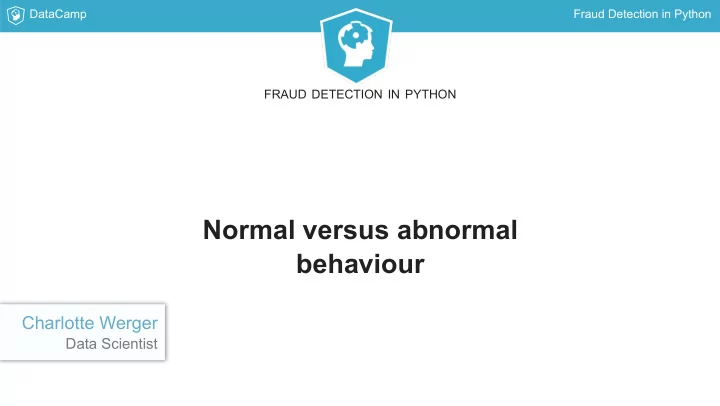

DataCamp Fraud Detection in Python FRAUD DETECTION IN PYTHON Normal versus abnormal behaviour Charlotte Werger Data Scientist
DataCamp Fraud Detection in Python Fraud detection without labels Using unsupervised learning to distinguish normal from abnormal behaviour Abnormal behaviour by definition is not always fraudulent Challenging because difficult to validate But...realistic because very often you don't have reliable labels
DataCamp Fraud Detection in Python What is normal behaviour? Thoroughly describe your data: plot histograms, check for outliers, investigate correlations and talk to the fraud analyst Are there any known historic cases of fraud? What typifies those cases? Normal behaviour of one type of client may not be normal for another Check patterns within subgroups of data: is your data homogenous?
DataCamp Fraud Detection in Python Customer segmentation: normal behaviour within segments
DataCamp Fraud Detection in Python FRAUD DETECTION IN PYTHON Let's practice!
DataCamp Fraud Detection in Python FRAUD DETECTION IN PYTHON Refresher on clustering methods Charlotte Werger Data Scientist
DataCamp Fraud Detection in Python Clustering: trying to detect patterns in data
DataCamp Fraud Detection in Python K-means clustering: using the distance to cluster centroids
DataCamp Fraud Detection in Python K-means clustering: using the distance to cluster centroids
DataCamp Fraud Detection in Python K-means clustering: using the distance to cluster centroids
DataCamp Fraud Detection in Python
DataCamp Fraud Detection in Python
DataCamp Fraud Detection in Python
DataCamp Fraud Detection in Python K-means clustering in Python # Import the packages from sklearn.preprocessing import MinMaxScaler from sklearn.cluster import KMeans # Transform and scale your data X = np.array(df).astype(np.float) scaler = MinMaxScaler() X_scaled = scaler.fit_transform(X) # Define the k-means model and fit to the data kmeans = KMeans(n_clusters=6, random_state=42).fit(X_scaled)
DataCamp Fraud Detection in Python The right amount of clusters Checking the number of clusters: Silhouette method Elbow curve clust = range(1, 10) kmeans = [KMeans(n_clusters=i) for i in clust] score = [kmeans[i].fit(X_scaled).score(X_scaled) for i in range(len(kmeans))] plt.plot(clust,score) plt.xlabel('Number of Clusters') plt.ylabel('Score') plt.title('Elbow Curve') plt.show()
DataCamp Fraud Detection in Python The Elbow Curve
DataCamp Fraud Detection in Python FRAUD DETECTION IN PYTHON Let's practice!
DataCamp Fraud Detection in Python FRAUD DETECTION IN PYTHON Assigning fraud versus non-fraud cases Charlotte Werger Data Scientist
DataCamp Fraud Detection in Python Starting with clustered data
DataCamp Fraud Detection in Python Assign the cluster centroids
DataCamp Fraud Detection in Python Define distances from the cluster centroid
DataCamp Fraud Detection in Python Flag fraud for those furthest away from cluster centroid
DataCamp Fraud Detection in Python Flagging fraud based on distance to centroid # Run the kmeans model on scaled data kmeans = KMeans(n_clusters=6, random_state=42,n_jobs=-1).fit(X_scaled) # Get the cluster number for each datapoint X_clusters = kmeans.predict(X_scaled) # Save the cluster centroids X_clusters_centers = kmeans.cluster_centers_ # Calculate the distance to the cluster centroid for each point dist = [np.linalg.norm(x-y) for x,y in zip(X_scaled, X_clusters_centers[X_clusters])] # Create predictions based on distance km_y_pred = np.array(dist) km_y_pred[dist>=np.percentile(dist, 93)] = 1 km_y_pred[dist<np.percentile(dist, 93)] = 0
DataCamp Fraud Detection in Python Validating your model results Check with the fraud analyst Investigate and describe cases that are flagged in more detail Compare to past known cases of fraud
DataCamp Fraud Detection in Python FRAUD DETECTION IN PYTHON Let's practice!
DataCamp Fraud Detection in Python FRAUD DETECTION IN PYTHON Other clustering fraud detection methods Charlotte Werger Data Scientist
DataCamp Fraud Detection in Python There are many different clustering methods
DataCamp Fraud Detection in Python And different ways of flagging fraud: using smallest clusters
DataCamp Fraud Detection in Python In reality it looks more like this
DataCamp Fraud Detection in Python DBScan versus K-means No need to predefine amount of clusters Adjust maximum distance between points within clusters Assign minimum amount of samples in clusters Better performance on weirdly shaped data But..higher computational costs
DataCamp Fraud Detection in Python Implementing DBscan from sklearn.cluster import DBSCAN db = DBSCAN(eps=0.5, min_samples=10, n_jobs=-1).fit(X_scaled) # Get the cluster labels (aka numbers) pred_labels = db.labels_ # Count the total number of clusters n_clusters_ = len(set(pred_labels)) - (1 if -1 in pred_labels else 0) # Print model results print('Estimated number of clusters: %d' % n_clusters_) Estimated number of clusters: 31
DataCamp Fraud Detection in Python Checking the size of the clusters # Print model results print("Silhouette Coefficient: %0.3f" % metrics.silhouette_score(X_scaled, pred_labels)) Silhouette Coefficient: 0.359 # Get sample counts in each cluster counts = np.bincount(pred_labels[pred_labels>=0]) print (counts) [ 763 496 840 355 1086 676 63 306 560 134 28 18 262 128 332 22 22 13 31 38 36 28 14 12 30 10 11 10 21 10 5]
DataCamp Fraud Detection in Python FRAUD DETECTION IN PYTHON Let's practice!
Recommend
More recommend